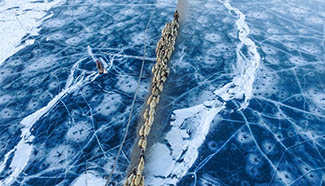SAN FRANCISCO, Feb. 18 (Xinhua) -- A new study shows that the 2015-16 El Nino was one of the strongest climate events in recent history with extraordinary winter wave energy, but its impact on beaches was greater in California than in Oregon and Washington, the three states on the U.S. West Coast.
The difference, according to researchers who reported their findings this week in Nature Communications, lies in the fact that Oregon and Washington as part of the U.S. Pacific Northwest had experienced comparatively mild wave conditions in the years prior to the onset of the El Nino, while California was experiencing a severe drought and "sediment starvation."
"You would have thought that there would be massive damage associated with (beach) erosion in Oregon and Washington with the strength of this El Nino," said Peter Ruggiero, an Oregon State University (OSU) coastal hazards expert and co-author on the study. "But the previous three years had mild winters and therefore the sand buildup was much higher than in California. It helped the Northwest offset the potential erosion from the El Nino."
The U.S. West Coast, on average, experienced a "shoreline retreat," or degree of beach erosion, that was 76 percent above normal and 27 percent higher than any other winter on record, eclipsing the El Nino events of 2009-10 and 1997-98. Coastal erosion was greatest in California, where 11 of the 18 beaches surveyed experienced historical levels of erosion.
In addition, said the professor in OSU's College of Earth, Ocean, and Atmospheric Sciences, Oregon and Washington have broader beaches than in California, which also eases the erosion of sand dunes and impacts to development.
"Rivers still supply the primary source of sand to California beaches, despite long-term reductions due to extensive dam construction," Patrick Barnard, a geologist with the U.S. Geological Survey (USGS) and lead author on the study, was quoted as in a news release from OSU. "But as California was in the midst of a major drought, the resulting lower river flows equated to even less sand being carried to the coast to help sustain beaches ... Therefore, many of the beaches in California were in a depleted state prior to the El Nino winters, and thereby were subjected to extreme and unprecedented landward erosion due to the highly energetic winter storm season of 2015-16."
The researchers believe the 2015-16 El Nino, in some ways, was stronger than the 1982-83 event, which caused an estimated 11.5 billion U.S. dollars in damages. Only a portion of the damage was directly related to coastal erosion, as it did to houses and roads. Most of the impact was from related storms, flooding and other damage that occurred inland.
The study, as the authors claim, is one of the first to document the oceanographic "forcing" directly related to beach impacts created by El Nino.












